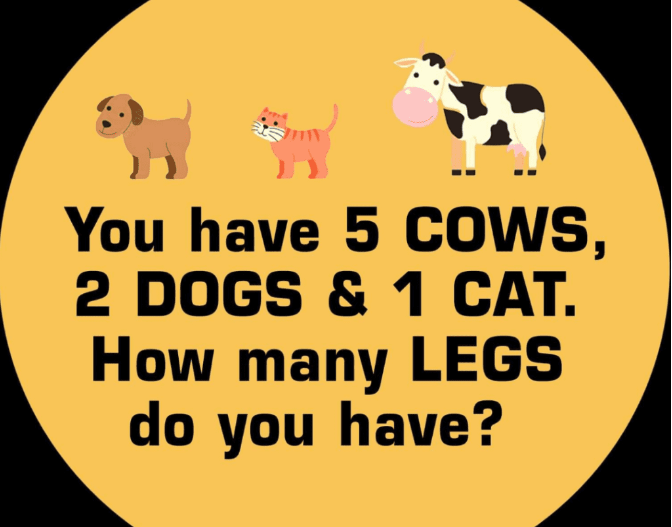In the intriguing universe of puzzles and riddles, some questions are crafted to test not just your logical thinking but also to lead you astray. One such example is the seemingly straightforward query: “You have 5 cows, 2 dogs, and 1 cat. How many legs do you have?” At first glance, this appears to be a simple math problem, but lurking beneath the surface is a clever trick designed to deceive. Let’s break down this riddle and explore the intricacies of deceptive questioning.

The Setup: A Logical Trap
When you first encounter the question about the number of legs, your instinct might be to calculate the total legs of all the animals listed. You might think, “Okay, let’s do some quick math!” But that’s the very trap set for you. The information about the animals shifts your focus away from the real subject—you.
Analyzing the Leg Count: What Are We Really Counting?
To illustrate the deceptive nature of this riddle, let’s analyze the leg count step by step:
- Cows: Each cow has four legs. So with 5 cows, you calculate
5×4=205×4=20 legs. - Dogs: Each dog also has four legs. For 2 dogs, that’s
2×4=82×4=8 legs. - Cats: A single cat has four legs as well. For 1 cat, that’s
1×4=41×4=4 legs.
When you add these together, you get:
20+8+4=3220+8+4=32 legs.
The Deceptive Question: What’s the Real Inquiry?
Here’s where the riddle takes a twist. It cleverly asks, “How many legs do YOU have?” This wording is crucial. While you’re busy counting the legs of the animals, the actual question refers to your own legs. The data about the animals is a mere distraction, a classic case of misdirection.
The Simple Answer: Only Two Legs
Once you cut through the deception, the answer becomes clear. As a human, you typically have two legs. The question was about you, not the animals. The inclusion of the animals was simply a clever ruse, a red herring designed to throw you off the scent.
Strategies to Avoid Deception in Questions
To prevent being misled by similar questions in the future, here are some effective strategies:
1. Read the Question Carefully
Always pay close attention to what the question is truly asking. If it pertains to you, focus on yourself without getting distracted by extraneous details.
2. Ignore the Noise
Recognize when unnecessary information is included to mislead you. Ask yourself if the details are relevant to answering the question.
3. Simplify the Problem
Break it down to its most basic components. If the question is about you, disregard other elements unless they directly relate to the answer.
4. Practice Mindful Thinking
Engage in activities that enhance your ability to focus and analyze information critically, like puzzles, brain games, and mindfulness exercises.
Conclusion: Mastering the Art of Deceptive Questions
In conclusion, the riddle about how many legs you have is a brilliant example of how easily we can be misled by irrelevant details. The key to solving such riddles lies in recognizing the true focus of the question and ignoring distractions. By understanding the psychology behind deceptive questioning, you can sharpen your critical thinking skills and become less susceptible to such tricks in the future.
So, the next time you encounter a question like this, remember to focus on the essentials. Sometimes, the answer is as simple as counting your own two legs. Embrace the challenge, and share this riddle with friends to see how they fare!


